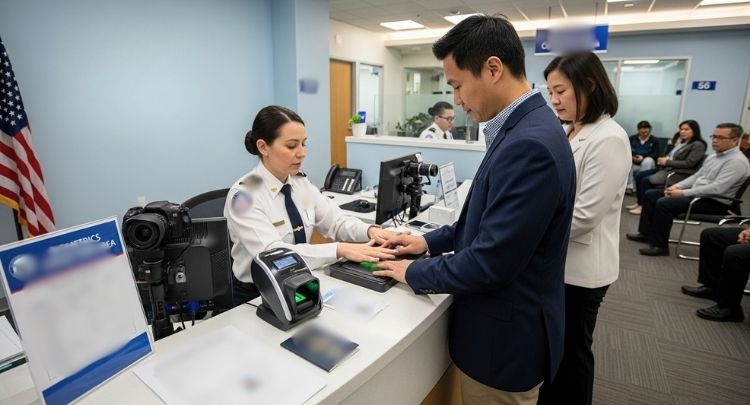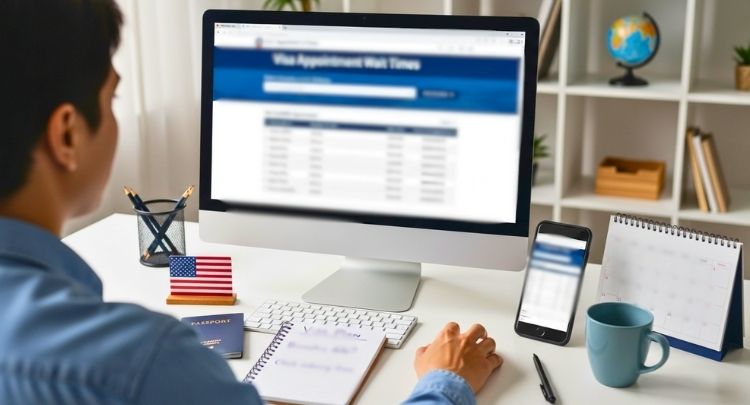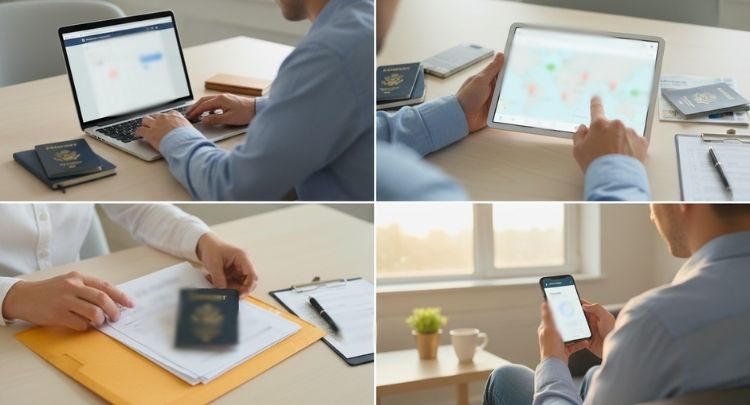Booking a biometric appointment is a key part of the U.S. visa or immigration process. Most people look forward to this step because it means their application is moving ahead. Around this point, many start to wonder how long it really takes, and some may even search for how many days does it take to get biometric appointment for US?
It typically takes 5 to 14 days to receive a biometric appointment notice for the US after USCIS accepts your application. In some cases, delays may extend the wait to 5–8 weeks depending on the local service center’s workload and application volume.
Want to know more about the timeline, documents, visa types, and what to expect at the appointment? Keep reading this article because everything you need to understand about biometric appointments is clearly explained here.
How Many Days Does it Take to Get Biometric Appointment for US?
Waiting for your biometric appointment can feel long and confusing sometimes. Usually, it depends on where you apply and how busy the service center is. In most cases, it does not take too long to get your notice. Let’s go through everything step by step below so you know what to expect.
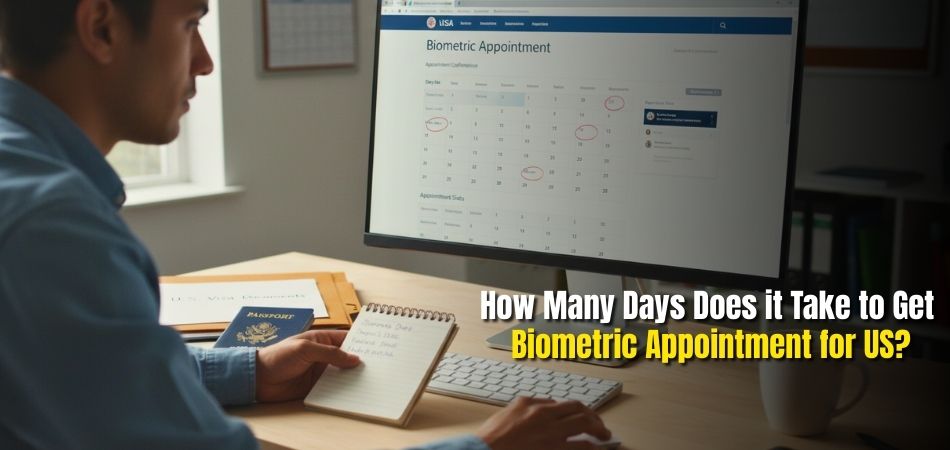
Average Waiting Time
Most people get their biometric appointment notice in about 5 to 14 days. The time can change based on how many people apply. Some areas process faster than others. If you applied online, you can also check updates on your USCIS account.
When It Takes Longer
Sometimes, there are more applications than usual. When that happens, you might wait 5 to 8 weeks. It depends on the local office and how many cases they handle. Try not to worry if it takes longer than normal.
How Location Affects the Time
Different USCIS centers have different workloads. If your local center is busy, the wait can be longer. Smaller centers might be faster. Always check your city’s processing time on the USCIS website.
What Happens at the Appointment
You will go through security first. Then they will take your fingerprints and photo. It usually takes 10 to 20 minutes. After that, you can leave. There is nothing special to prepare for.
If You Miss the Appointment
If you cannot go, you must reschedule right away. Follow the steps on your notice to ask for a new date. Do not ignore it because it can delay your case. USCIS is usually understanding if you have a good reason.
Checking Your Case Status
You can track your application anytime on the USCIS website. Enter your receipt number to see the latest update. It will show when your biometric data was received. This helps you know your process is moving forward.
Useful Tip for Applicants
Always keep a copy of your appointment letter. Save it with your immigration papers for later use. If you are preparing for business events like conferences in USA, it is smart to plan your schedule around your USCIS dates.
The biometric process is simple once you understand how it works. Most people finish this step within a few weeks. Just stay patient and keep checking your mail or online account. Following these small tips will make your process easier and faster.
US Biometric Appointment Wait Times by Visa Type
When applying for a U.S. visa, your biometrics (fingerprints and photo) are a required part of the process. They help verify your identity and maintain security during visa processing. The wait time for biometric appointments depends on your visa type and where you are applying from—inside or outside the United States. Below is a detailed look at how biometric appointments work for different visa categories.
1. Nonimmigrant Visas (Applied Outside the U.S.)
Visitor Visas (B1/B2)
For visitor visas, biometrics are usually taken during your visa interview or at a Visa Application Center (VAC) shortly before it.
- Wait Time: Matches your embassy or consulate’s B1/B2 interview wait time.
- Special Cases: In some countries like the Philippines, you must schedule the VAC appointment before the interview.
- Tip: You can check your estimated wait time using the U.S. department of state visa appointment wait times tool for your specific location.
Students and Exchange Visitors (F, M, J)
Students and exchange program applicants have their biometrics taken during their visa interview.
- Wait Time: Follows your embassy’s “Student/Exchange” visa queue.
- Booking: Usually scheduled the same way as the interview process.
Work and Other Petition-Based Visas (H, L, O, P, Q, etc.)
Applicants for employment-related visas also complete biometrics during their interview.
- Wait Time: Depends on your post’s “All other nonimmigrant visas” queue.
- Separate VAC Posts: In countries such as India and the Philippines, you book two appointments—one for VAC (photo and fingerprints) and another for the interview. The VAC date is typically a few days to two weeks before the interview.
2. Immigrant Visas (CR/IR Family, Employment, and Diversity Visas)
For immigrant visa applicants, biometrics are part of the interview at the U.S. Embassy or Consulate.
- No Separate Appointment: You don’t need a separate biometric slot.
- Timing: The interview date is set by the National Visa Center (NVC) and your specific U.S. post.
- Process: During the interview, fingerprints and photographs are collected as part of your visa procedure.
3. Inside the U.S. (USCIS Application Support Centers – ASC)
For Applicants Filing with USCIS
If you are applying for immigration benefits inside the United States, such as:
- Adjustment of Status (Form I-485)
- Work Authorization (Form I-765)
- Travel Document (Form I-131)
- Citizenship (Form N-400)
- Other applications like I-539, I-751, or I-90
USCIS will send you a biometrics appointment notice after you file.
- Average Wait Time: Around 5 to 8 weeks from the date of filing.
- Appointment Duration: Takes about 15 to 20 minutes at the ASC.
- Possible Reuse: Sometimes USCIS reuses your previous biometrics, meaning you may not need a new appointment.
Biometric appointments are an important step in the U.S. visa and immigration process. The wait times can differ based on visa type and location, but in most cases, biometrics are either completed during your interview or scheduled a few weeks after applying.
US Biometric Appointment Timeline: What to Expect Step by Step?
Whether you’re filing your case inside the United States or applying for a visa outside the country, the biometric process follows a clear sequence. Here’s what you can expect at every stage.
1. Receipt Notice (Form I-797C)
After filing your case, USCIS will send you a receipt notice confirming they have received your application. This notice includes your case number and filing date.
Most applicants receive it within 2–4 weeks after submission. Once you get it, the next step is waiting for your biometrics appointment notice.
2. Biometrics Appointment Notice
The ASC Appointment Notice will provide your appointment date, time, and location.
Usually, this arrives about 5–8 weeks after filing, though timing varies depending on where you live and USCIS workload.
3. What to Bring
On the day of your appointment, make sure to bring:
- Your appointment notice (Form I-797C)
- A valid photo ID such as a passport, driver’s license, or green card
If you have received multiple notices, take all copies to your appointment.
4. What Happens at the ASC
At the Application Support Center (ASC), your fingerprints, photo, and digital signature will be collected.
The process is quick—usually 15 to 20 minutes—and it helps USCIS confirm your identity and run necessary background checks.
5. Rescheduling If Needed
If you cannot attend your appointment, log in to your USCIS online account to reschedule before your appointment time.
Failing to attend without notice could delay your case significantly.
6. After the Biometrics Appointment
Once your biometric appointment is completed, the visa processing after biometrics phase begins, where U.S. immigration officers verify your identity, run background checks, and decide whether to move your case forward for approval.
Your case then continues through the regular processing steps, and the total timeline depends on the type of application you submitted—such as a green card, work permit, or citizenship request.
Biometrics for U.S. Visa Applicants Outside the U.S.
If you’re applying for a U.S. visa from abroad, the steps are managed by U.S. embassies or consulates.
Scheduling and Appointment Setup
Most applicants have two appointments—one at a VAC (Visa Application Center) or OFC (Offsite Facilitation Center) for biometrics, and another at the U.S. consulate for the interview.
These appointments are scheduled automatically when you book your visa interview.
Biometrics Collection
During your VAC or OFC visit, staff will digitally scan your fingerprints and capture your photo.
The visit itself usually takes about 15–30 minutes.
Interview Day
If your biometrics aren’t taken beforehand, they will be collected on your interview day.
Processes can vary slightly depending on your embassy or consulate location.
Quick Tips
- Arrive early and bring your notice and photo ID.
- Many centers restrict phones and bags, so check their rules.
- If you can’t attend, reschedule ahead of time to avoid case delays.
- On average, biometrics are completed 5–8 weeks after filing inside the U.S., though exact timing depends on workload and location.
Required Documents for Your US Biometric Appointment
Before you visit your U.S. biometric appointment, make sure you have all the right papers ready. These documents confirm your identity and help USCIS verify your application. Here’s a simple list based on official USCIS biometrics appointment instructions.
- Appointment Notice (Form I-797C): This letter confirms your date, time, and location for biometrics. It’s your entry ticket to the center and shows USCIS has officially scheduled your appointment.
- Valid Photo ID: Bring a government-issued identification like your passport, driver’s license, or Green Card. It helps the officer match your personal details with your submitted application information.
- Passport or Travel Document: Your passport verifies your nationality, travel history, and identity. Always carry the original, especially if your biometric appointment is connected to a visa or immigration case.
- Previous Passports (If Applicable): Keep older passports handy if they contain past U.S. visas or travel records. Officers sometimes review these to confirm previous entries or visa details.
- Visa Application Confirmation (DS-160 or Appointment Page): Visa applicants must carry this page to link biometric data to their online visa profile and prevent mismatched information in the system.
- Recent Passport-Size Photos: Some visa centers require printed photos even if a digital image was uploaded earlier. Always double-check your appointment letter for specific photo requirements.
- Supporting Identification Documents (If Requested): Bring extra documents like a birth certificate, work permit, or student ID if requested. Having backups ready helps in case further verification is needed.
Before leaving home, review your appointment letter carefully and organize all items in a folder. Being fully prepared with the documents mentioned in the USCIS biometrics appointment instructions helps you complete your visit quickly and avoid unnecessary delays.
How to Check Current Biometric/Visa Appointment Wait Times for US?
If you’re planning to apply for a U.S. visa, knowing how long you’ll wait for your biometric or visa appointment can help you plan better. The U.S. Department of State provides an official online tool to check estimated wait times for visa appointments at different embassies and consulates.
Where to Check Wait Times
The U.S. Department of State hosts a live tool called “Visa Appointment Wait Times” for non-immigrant visas.
On that page, you can select the U.S. embassy or consulate where you plan to apply — for example, the one located in your country.
Once selected, you’ll see estimated wait times for different visa types such as:
- Visitor visas (B-1/B-2)
- Student visas (F-1, M-1)
- Work visas (H, L, etc.)
These estimates show the next available appointment date and give you an idea of how soon you may get an interview slot.
How to Check – Step by Step
- Go to the official Visa Appointment Wait Times page on the U.S. Department of State’s website.
- Select your country and the specific U.S. embassy or consulate where you’ll submit your visa application.
- Choose your visa type, such as a visitor, student, or work visa.
- View the “Next Available Appointment” date shown on the page. This tells you how long you may need to wait for your appointment.
- Check back often, because appointment slots can change. Many consulates update their schedules regularly, and earlier dates may open up unexpectedly.
What the Tool Tells You (and What It Doesn’t)
The wait-time tool gives you an estimated timeline, not a confirmed appointment. Dates can change depending on embassy workload, staffing, and local conditions.
It mainly covers visa interview or appointment scheduling times, not the total processing time or visa approval period.
If you’ve already received an official appointment notice (for biometrics or interview), always follow the information on that letter, as it’s your true appointment confirmation.
Why Biometric Appointment Wait Times Vary in US: Key Factors (Visa type, Country, Backlog, Demand)
Many people notice that biometric appointment wait times are different from place to place. Several things can affect how long it takes to get an appointment. Each factor plays a part in how fast your case moves. Read below to understand the key reasons clearly.
Visa Type and Where You Apply
Different visa categories and application locations create different timelines. For example, the biometric requirement for conference visa applicants can sometimes result in faster scheduling compared to long-term visa types, since these are usually short-stay business visits. Consular offices abroad may collect fingerprints before or during interviews, while USCIS handles biometrics separately inside the United States.
Country and Local Post Capacity
The time you wait can change based on where you apply. Each embassy or consulate has its own team, schedule, and workload. Busy cities usually have longer lines. In countries like India, some posts report shorter waits while others take longer due to local demand and available staff.
Backlogs, Staffing, and Closures
Delays often happen when there are backlogs or not enough staff. USCIS and consulates both depend on available workers and open hours. Sometimes, unexpected office closures or holidays push dates further out. Checking the official USCIS site for closure notices before your visit can save time.
Demand Spikes and Seasonality
High-demand seasons can quickly fill appointment slots. For instance, when students apply for U.S. study visas or travelers plan summer trips, appointment systems get crowded. Consulates may need to add more hours or staff, but it still takes time for wait periods to return to normal.
Policy Rules That Change Who Needs Biometrics
Not everyone has to attend a new biometric appointment each time they apply. USCIS may reuse your old fingerprints if they are still valid. This helps reduce waiting time for others. Also, new online rescheduling rules make it easier to adjust appointments but can slightly shift local slot availability.
Security and Screening Needs
Biometric data is used to confirm identity and complete background checks. Sometimes, these checks require extra steps, especially during sensitive or high-risk periods. This can affect how appointments are grouped and when new slots open for scheduling.
Waiting times for biometrics depend on many moving parts. Where you apply, your visa type, and even local demand matter. Always check the latest information from the U.S. Department of State or USCIS. Doing this helps you plan your next step with confidence.
Recent Global Trends That Affect Biometric Appointment Wait Times in US
Biometric appointment wait times in the U.S. continue to shift worldwide. Many factors, including staffing, demand, and new policies, shape these changes. Countries respond differently to these updates. The points below explain how recent trends and USCIS Newsroom Updates influence processing.
- Higher Demand in Major Countries: After the pandemic, big markets like India and Brazil faced heavy visa demand. The Department of State worked toward reducing visitor visa interview waits to under 90 days at most posts worldwide.
- Added Staffing and Extra Slots: Consulates added more officers and created extra time slots for interviews. India introduced “special Saturday” interview days in 2024, helping shorten queues and speed up appointment availability across major cities.
- Policy and System Improvements: USCIS released updates in its Policy Manual to improve how biometrics appointments are managed. These steps made scheduling and rescheduling smoother, especially for people visiting Application Support Centers for fingerprinting.
- Reuse of Biometrics: The Department of Homeland Security suggested reusing existing biometric data in 2025. This plan helps cut unnecessary repeat appointments, allowing faster case movement while still confirming identity through secure verification systems.
- Investment in USCIS Centers: USCIS improved technology across 130 biometric centers nationwide. Upgraded systems, combined with trained staff, helped handle higher applicant volumes and reduced delays in collecting fingerprints and photos at busy locations.
- Uneven Recovery Between Locations: Progress varies by region. India’s cities showed better performance late in 2025, while other countries still struggled with long waits due to uneven staffing levels and growing visa demand.
- Event and Seasonal Pressures: Large events, such as the 2026 World Cup, can spike travel-related visa requests. When this happens, consulates shift resources or extend working hours to manage the sudden rise in appointment demand.
Biometric wait times are improving overall but remain uneven across locations. Staffing, technology, and new policies make a clear difference. Following USCIS newsroom updates helps applicants track these improvements and plan their visa or biometric appointments more efficiently in the coming months.
How to Handle Long Biometric Appointment Wait Times?
Sometimes biometric appointment waits can feel longer than expected. The good news is that there are smart ways to manage the delay. Simple actions can help you move faster through the system. Read below for clear and practical steps to reduce your waiting time.
Check for New Slots or Cancellations
Appointment slots often open when others cancel or reschedule. Visit the official U.S. Department of State wait-time page regularly. It shows the next available dates for your visa type. Checking often gives you a better chance of finding an earlier slot.
Try Different Locations (If Allowed)
Some visa centers or consulates handle fewer applicants. If your application type allows it, choose a different center with shorter waits. A nearby city might have open times sooner than the one you first picked for your appointment.
Book Early for Future Travel
Planning early helps you stay ahead of delays. If you know your travel dates, apply months in advance. This gives time for possible backlogs or rescheduling. Early action reduces stress and keeps your travel plans safe from sudden appointment changes.
Keep Your Application Complete
Missing or incorrect documents can cause major slowdowns. Double-check every form and file before you submit. Keep digital and printed copies ready. A complete application ensures you can act fast whenever a new appointment becomes available.
Reschedule Only When Necessary
Changing your biometric appointment should be done carefully. Use your official USCIS online account to reschedule only for a good reason. Missing your appointment without notice can delay or even harm your visa or immigration case.
Monitor Case Status Regularly
After giving your biometrics, some visa cases may enter “administrative processing.” That means extra checks are still running. Watching your case status online helps you see updates, stay informed, and know when to expect the next step.
Be Patient and Stay Flexible
Even with good planning, delays can happen. Holidays, busy seasons, or local demand might cause slower processing. Staying calm and flexible helps you handle these times better while waiting for updates on your appointment.
Waiting for biometric appointments can test your patience, but small steps make a big difference. Check regularly, keep your documents ready, and follow USCIS instructions carefully. Staying informed helps you handle the process smoothly from start to finish.
Commonly Asked Questions
Understanding the biometric appointment process for U.S. visas or immigration can be confusing, especially with different timelines and rules. These FAQs answer the most common questions about how long it takes, what affects the timing, and how to handle your appointment smoothly.
What Should I Do If I Don’t Receive My Biometric Appointment Notice?
If you haven’t received your biometric notice after a few weeks, the first thing to do is check your USCIS online account. Sometimes notices are delayed in the mail but already available online. If you still can’t find it after 30 days, contact USCIS through their customer service or online inquiry form. Always make sure your mailing address is up to date to avoid missing future notices.
Can I Walk In for My Biometric Appointment Without a Notice?
No, you can’t walk in without a valid appointment notice. The notice has a barcode and appointment details that USCIS uses to verify your booking. If you go without it, the staff will not be able to process your biometrics. Wait for your notice or request a replacement if it was lost.
Does Filing Online Make My Biometric Appointment Faster?
In most cases, filing online helps USCIS process your application faster. Your documents are received instantly, and your case enters the queue without postal delays. However, the actual biometrics schedule still depends on how busy your local center is. So while online filing saves time upfront, the appointment timing may still vary.
Can I Choose My Own Date for the Biometric Appointment?
No, USCIS assigns your appointment date automatically. You can request a new date only if you have a serious reason, like illness or travel emergencies. Use your USCIS account or follow the reschedule instructions on your notice. It’s best to avoid changing dates unless necessary because rescheduling can delay your case.
What Happens If I Go Late to My Biometric Appointment?
If you arrive late, the staff may not allow you to check in. Every ASC center follows strict time slots to manage visitors smoothly. If you miss your time completely, you’ll need to reschedule, which can take a few more weeks. Always plan to arrive at least 15–20 minutes early.
Do I Need to Pay Extra Fees for Biometric Appointments?
Usually, the biometric fee is already included in your application payment. You do not need to pay again for the appointment itself. If someone asks you to pay separately, it may be a scam. Always confirm payment details on the official USCIS website before making any transactions.
Bottom Line
Knowing how the biometric process works can ease a lot of stress. After filing your application, you’ll first receive a receipt notice. Then, the biometric appointment notice usually comes in around 5 to 8 weeks, depending on where you applied and how busy the center is. In some places, people get scheduled sooner. So if you’re wondering how many days does it take to get biometric appointment for US? the short answer is it often takes between 35 to 56 days after you file your case.
As you wait, keep checking your USCIS account and mail regularly. Make sure your documents are ready, show up early, and follow instructions closely. If you need to reschedule, do it early online to avoid delays. A calm, organized approach goes a long way. Good luck with your appointment and all the best on the next step in your journey!


